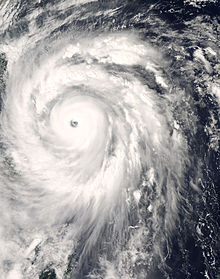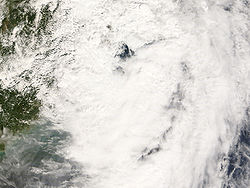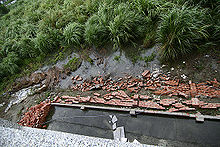- Typhoon Jangmi (2008)
-
Typhoon Jangmi (Ofel) Typhoon (JMA) Category 5 super typhoon (SSHS) 
Typhoon Jangmi at peak Formed September 23, 2008 Dissipated October 1, 2008 Highest winds 10-minute sustained:
215 km/h (130 mph)
1-minute sustained:
270 km/h (165 mph)Lowest pressure 905 mbar (hPa; 26.72 inHg) Fatalities 6 total Damage $240.4 million (2008 USD) Areas affected Philippines, Taiwan, the People's Republic of China and Japan Part of the 2008 Pacific typhoon season Typhoon Jangmi (international designation: 0815, JTWC designation: 19W, PAGASA name: Ofel) was the most intense tropical cyclone to develop worldwide during 2008 with a pressure of 905 hPa.[1] Structural damage from the typhoon is estimated at $240 million (USD) [2] and agricultural losses totaled to NT$ 16,375,000 ($494,262 USD).[3]
Contents
Meteorological history
On September 23, 2008, a tropical disturbance formed in the western Pacific ocean, to the south-west of Guam.[4] Later that day the Joint Typhoon Warning Center assessed the disturbance's chances of becoming a significant tropical cyclone within 24 hours as poor.[4] This assessment was due to the disturbance having a weak Low level Circulation Center.[4] Later that day the JTWC reassessed its chances of becoming a significant tropical cyclone within 24 hours to "Fair".[5] This was because the disturbance's Low Level Circulation Center had developed further within the previous six hours while remaining stationary.[5] The Japan Meteorological Agency then designated the disturbance as a minor tropical depression, later that evening the JTWC upgraded the disturbances chances of developing in to a significant tropical cyclone to "Good".[6][7] This came as the JTWC issued a Tropical Cyclone Formation Alert on the disturbance as it moved towards the west.[7] Later on September 23, the JTWC reported that the disturbance had intensified in to a tropical depression and designated it as Tropical Depression 19W.[8]
Early on September 24, the JMA started to issue full advisories on the tropical depression, while the JTWC reported that the depression had intensified in to a tropical storm.[9][10] Early that afternoon the JMA assigned the international name of Jangmi, to the tropical storm.[11] Jangmi then moved in to PAGASA's Area of Responsibility who assigned the local name Ofel to tropical storm Jangmi.[12] The JMA then reported that Jangmi had intensified in to a severe tropical storm early the next day.[13] Later that day both the JMA and the JTWC reported that Jangmi had intensified further and had become a Typhoon.[14] Early the next day the JTWC reported that Jangmi had intensified in to a category two typhoon on the Saffir-Simpson Hurricane Scale with winds of 90 knots (105 mph 165 km/h).[15] While the JMA were reporting that Jangmi had winds of 80 knots[16] Later that day the JTWC reported that Jangmi had rapidly intensified within the last six hours to become a category four typhoon.[17] Meanwhile the JMA were reporting that Jangmi had winds of 100 knots[18] Early on September 27 the JTWC reported that Jangmi had continued to intensify and reached its peak wind speeds of 135 kts (155 mph, 250 km/h) which made Jangmi a super typhoon.[19] At this time the JMA were still reporting that Jangmi had winds of 100 knots (190 km/h).[20] Later that day as the outer bands of Jangmi started to interact with the Taiwan's coast, the JMA reported that Jangmi had reached its peak winds of 115 knots (213 km/h) and had a minimum pressure of 910 hPa.[21]
Throughout September 27 the JTWC kept Jangmi as a category four super typhoon with winds of 135 knots (250 km/h).[22] Early the next day, Jangmi weakened into a Category four typhoon with winds of 115 kts (130 mph 210 km/h).[22] While the JMA reported that Jangmi had winds of 110 knots (200 km/h). Later that morning, Jangmi made landfall in Yilan County on the east coast of Taiwan.[23] The JMA reported that Jangmi had winds of 105 knots (194 km/h) while the JTWC reported that Jangmi had winds of 115 kts (130 mph 210 km/h) at the time of landfall.[22][24] After making landfall on Taiwan during September 28, Jangmi weakened in to a category two typhoon with 85 knots (157 km/h), (100 mph, 155 km/h). The JMA at this time were reporting that Jangmi had winds of 75 knots (139 km/h).[25][26]
Later that day, Jangmi moved to the north-east and moved back over the East China Sea. Jangmi then weakened into a category one typhoon while the JMA reported that Jangmi had weakened into a Severe Tropical Storm.[27][28] Early the next morning the JTWC downgraded typhoon Jangmi to a tropical storm.[29] As Jangmi moved closer towards Japan and out of PAGASA's area of responsibility the JMA downgraded Jangmi to a tropical storm.[30][31] Late the next day the JTWC reported that the Jangmi had become extra tropical.[32] As a result of this the JTWC issued their final advisory on Jangmi.[32] The JMA then followed suit within their next advisory, declaring it as a developing low.[33] The JMA reported in their best track that the low dissipated on October 5.[1]
Operationally the Joint Typhoon Warning Center measured the peak wind speeds at 135 knots (250 km/h), which is a category four super typhoon.[22] During their post storm analysis the JTWC determined that Jangmi had carried on intensifying during September 27, and had reached peak winds of 270 km/h (165 mph) later that day. This made Jangmi a category five super typhoon on the Saffir Simpson Hurricane Scale.[34] Within their post storm analysis the Japan Meteorological Agency revised the lowest pressure of Jangmi. Operationally the JMA measured the lowest pressure of Jangmi at 910 hPa, However in their best track the lowest pressure they measured was 905 hPa.[1]
Preparations
Taiwan made hbv preparations for a late Sunday landfall. All local governments in Taiwan proper called off classes and government work for Sunday, September 28, while Penghu County in the Taiwan Strait called off classes for the afternoon. For public safety reasons, September 29 was later declared a public holiday as well. Ferry service from Taitung to Green Island was canceled for three days, starting on September 28. Taiwan Railways Administration and Taiwan High Speed Rail trains were temporarily suspended as well.
China
Late on September 27 the Chinese Meteorological Association issued a Red Typhoon warning in preparation for super typhoon Jangmi.[35]
Impact
Taiwan
Taiping Mountain in Yilan County registered 692 mm (27.24 in) of rain according to the 0415 UTC advisory while Nangang in Taipei City in northern Taiwan reported 463 mm (18.22 in) of precipitation. The highest recorded rainfall was registered in Tatung Town at 1,124 mm (44.27 in).[36] However, some estimates showed over 1,400 mm (55 in) falling the mountainous regions.[37] Landslides were reported in many mountain areas already saturated by Typhoon Sinlaku, which passed by two weeks earlier.[36] About 154,266 residences on the island lost power due to the storm.[38] A bus near Yilan City was blown over by the strong winds produced by the storm, injuring the 36 passengers inside. One man was killed after he fell into a flooded rice paddy and a teenage girl was electrocuted after an electrical wire fell on her.[39]
Japan
Prior to striking Taiwan, Typhoon Jangmi brushed Okinawa Prefecture on September 27, bringing strong winds and moderate rainfall, peaking at 137 mm (5.4 in) to the islands.[40] Ishigaki Island sustained the most severe damage after a dike collapsed, flooding the surrounding areas.[41] Much of the prefecture was left without power as winds gusted to 110 km/h (70 mph).[42] Throughout the prefecture, four people were killed and six others were injured, two of whom sustained severe injuries.[41][43][44] Damage from the storm amounted to 65.2 million yen ($746,670 USD).[41] By October 1, the remnants of Jangmi brought heavy rains and strong winds to Kyūshū. The highest rainfall total was measured in Satsumakashiwabaru, in the Kagoshima Prefecture, at 380 mm (15 in).[40] In the prefecture, these rains triggered 42 landslides and flooded seven homes, three of which were left with severe damage. A total of 334 hectares of farmland was damaged by Jangmi, leaving 15.4 million yen ($176,360 USD) in losses.[45] In Miyazaki Prefecture, one person was injured and three homes were damaged after a hillside collapsed.[46]
Intensity and naming
On September 27, Typhoon Jangmi attained its peak intensity with winds of 215 km/h (135 mph) and a barometric pressure of 905 mbar (hPa; 26.72 inHg) according to the JMA.[1] At the same time, the JTWC classified the system as a stronger storm, peaking as a Category 5 equivalent typhoon with winds of 270 km/h (165 mph) with a slightly higher pressure of 918 mbar (hPa; 27.11 inHg). This made Jangmi the strongest tropical cyclone in both the western Pacific and worldwide during 2008. Being the only Category 5 equivalent storm in any basin during 2008, it marked the lowest number of cyclones of this intensity since 1974 when there were none.[47] However, operationally, Jangmi was not considered a Category 5 by the JTWC; the initial intensity was set at 250 km/h (155 mph) and was later raised during post-season analysis.
The name Changmi was one of the 10 original names submitted by the Republic of Korea to the ESCAP/WMO Typhoon Committee for use from January 1, 2000. The name 'Changmi' is Korean for 'rose' and was last used in the 2002 Pacific typhoon season.[48] At the 2007 meeting of the typhoon committee, the Republic of Korea submitted a request to change the spelling of Changmi to Jangmi. This request was approved with the change being effective from January 1, 2008.[49]
The Philippine Atmospheric, Geophysical and Astronomical Services Administration (PAGASA) assigned the local name of Ofel to Jangmi. Ofel was last used by PAGASA to name a tropical depression in the Philippines in 2004 to name Tropical Storm Haima. If the name Ofel is not retired by PAGASA at the end of the 2008 Typhoon Season then it will be reused in the 2012 Pacific typhoon season.
References
- ^ a b c d "JMA best track:Jangmi". Japan Meteorological Agency. http://www.webcitation.org/5cAYA5c4X. Retrieved 2008-11-09.
- ^ http://www.businessinsurance.com/cgi-bin/news.pl?post_date=2008-10-01&id=14091
- ^ "Typhoon Jangmi Disaster Responses Reports". Central Emergency Operation Center. 2008-09-29. http://74.125.45.132/search?q=cache:Y3NS8WG2rF0J:www.nfa.gov.tw/en/DownLoader.aspx%3FFN%3D2008%255C20080929%255C2008929215450687.pdf%26TYPE%3D4+Typhoon+Jangmi+report&hl=en&ct=clnk&cd=10&gl=us. Retrieved 2009-01-08.
- ^ a b c "ABWP10 23-09-08 06z". Joint Typhoon Warning Center. ftp://ftp.met.fsu.edu/pub/weather/tropical/GuamStuff/2008092306-ABPW.PGTW. Retrieved 2008-11-09.
- ^ a b "ABWP10 23-09-08 13z". Joint Typhoon Warning Center. ftp://ftp.met.fsu.edu/pub/weather/tropical/GuamStuff/2008092313-ABPW.PGTW. Retrieved 2008-11-09.
- ^ "WWJP25 23-09-08 18z". Japan Meteorological Agency. ftp://ftp.met.fsu.edu/pub/weather/tropical/Tokyo/2008092318.RJTD. Retrieved 2008-11-09.
- ^ a b "Tropical Cyclone Formation Alert 23-09-08 19z". Joint Typhoon Warning Center. ftp://ftp.met.fsu.edu/pub/weather/tropical/GuamStuff/2008092319-WTPN.PGTW. Retrieved 2008-11-09.
- ^ "JTWC Warning 23-09-08 21z". Joint Typhoon Warning Center. ftp://ftp.met.fsu.edu/pub/weather/tropical/GuamStuff/2008092321-WTPN.PGTW. Retrieved 2008-11-09.
- ^ "JMA Advisory 24-09-08 00z". Japan Meteorological Agency. http://www.webcitation.org/5b3rjjyyG. Retrieved 2008-11-09.
- ^ "JTWC Warning 24-09-08 03z". Joint Typhoon Warning Center. ftp://ftp.met.fsu.edu/pub/weather/tropical/GuamStuff/2008092403-WTPN.PGTW. Retrieved 2008-11-09.
- ^ "JMA Advisory 24-09-08 12z". Japan Meteorological Agency. http://www.webcitation.org/5b4jX5m3o. Retrieved 2008-11-09.
- ^ "PAGASA Advisory 24-09-08 21z". Philippine Atmospheric, Geophysical and Astronomical Services Administration. http://www.webcitation.org/5b5FciPnV. Retrieved 2008-11-09.
- ^ "JMA Advisory 25-09-08 00z". Japan Meteorological Agency. http://www.webcitation.org/5b5QfMcrc. Retrieved 2008-11-09.
- ^ "JMA Advisory 25-09-08 18z". Japan Meteorological Agency. http://www.webcitation.org/5b6UokTCl. Retrieved 2008-11-09.
- ^ "JTWC Warning 26-09-08 03z". Joint Typhoon Warning Center. ftp://ftp.met.fsu.edu/pub/weather/tropical/GuamStuff/2008092603-WTPN.PGTW. Retrieved 2008-11-09.
- ^ "JMA Advisory 26-09-08 03z". Japan Meteorological Agency. http://www.webcitation.org/5b74GAZJM. Retrieved 2008-11-09.
- ^ "JTWC Warning 26-09-08 21z". Joint Typhoon Warning Center. ftp://ftp.met.fsu.edu/pub/weather/tropical/GuamStuff/2008092621-WTPN.PGTW. Retrieved 2008-11-09.
- ^ "JMA Advisory 26-09-08 21z". Japan Meteorological Agency. http://www.webcitation.org/5b8CV0A3l. Retrieved 2008-11-09.
- ^ "JTWC Warning 27-09-08 03z". Joint Typhoon Warning Center. ftp://ftp.met.fsu.edu/pub/weather/tropical/GuamStuff/2008092703-WTPN.PGTW. Retrieved 2008-11-09.
- ^ "JMA Advisory 27-09-08 00z". Japan Meteorological Agency. http://www.webcitation.org/5b8OTIn6I. Retrieved 2008-11-09.
- ^ "JMA Advisory 27-09-08 12z". Japan Meteorological Agency. http://www.webcitation.org/5b9HZWjcv. Retrieved 2008-11-09.
- ^ a b c d "Gary Padgett's Global Tropical cyclone tracks - September 2008". Australian Severe Weather. http://www.australiasevereweather.com/cyclones/2009/trak0809.htm. Retrieved 2008-11-09.
- ^ ""Jangmi" has landed in Yilan County of Taiwan Province". CMA. http://www.cma.gov.cn/en/news/200809/t20080928_18090.html. Retrieved 2008-10-01.
- ^ "JMA Advisory 28-09-08 06z". Japan Meteorological Agency. http://www.webcitation.org/5bAIyw2hV. Retrieved 2008-11-09.
- ^ "JMA Advisory 28-09-08 15z". Japan Meteorological Agency. http://www.webcitation.org/5bArQbtQB. Retrieved 2008-11-09.
- ^ "JTWC Warning 27-09-08 03z". Joint Typhoon Warning Center. ftp://ftp.met.fsu.edu/pub/weather/tropical/GuamStuff/2008092815-WTPN.PGTW. Retrieved 2008-11-09.
- ^ "JMA Advisory 28-09-08 21z". Japan Meteorological Agency. http://www.webcitation.org/5bBGuYovp. Retrieved 2008-11-09.
- ^ "JTWC Warning 28-09-08 21z". Joint Typhoon Warning Center. ftp://ftp.met.fsu.edu/pub/weather/tropical/GuamStuff/2008092821-WTPN.PGTW. Retrieved 2008-11-09.
- ^ "JTWC Warning 29-09-08 03z". Joint Typhoon Warning Center. ftp://ftp.met.fsu.edu/pub/weather/tropical/GuamStuff/2008092803-WTPN.PGTW. Retrieved 2008-11-09.
- ^ "PAGASA Advisory 29-09-08 03z". Philippine Atmospheric, Geophysical and Astronomical Services Administration. http://www.webcitation.org/5bBbPe3jj. Retrieved 2008-11-09.
- ^ "JMA Advisory 29-09-08 12z". Japan Meteorological Agency. http://www.webcitation.org/5bCD76Bm3. Retrieved 2008-11-09.
- ^ a b "JTWC Warning 29-09-08 21z". Joint Typhoon Warning Center. ftp://ftp.met.fsu.edu/pub/weather/tropical/GuamStuff/2008092921-WTPN.PGTW. Retrieved 2008-11-09.
- ^ "JMA Advisory 01-10-08 00z". Japan Meteorological Agency. http://www.webcitation.org/5bEUv1lwE. Retrieved 2008-11-09.
- ^ NRL (2008). "JTWC Best Track 19W". Navy Research Laboratory. http://199.9.2.143/tcdat/tc08/WPAC/19W.JANGMI/trackfile.txt. Retrieved 2008-09-30.
- ^ "CMA Advisory 27-9-08 22z". CMA. http://www.cma.gov.cn/en/news/200809/t20080928_18044.html. Retrieved 2008-10-01.
- ^ a b "Typhoon Jangmi Central emergency operation center No.4". Central emergency operation center. 2008-09-29. http://www.nfa.gov.tw/en/DownLoader.aspx?FN=2008%5c20080930%5c2008930175616375.pdf&TYPE=4. Retrieved 2009-01-13.
- ^ Lin Liyu (September 28, 2008). "Violent typhoon Jangmi hits Taiwan". Xinhua News Agency. http://news.xinhuanet.com/english/2008-09/28/content_10129563.htm. Retrieved February 16, 2009.
- ^ Staff Writer (September 29, 2008). "Taiwan reports disruption caused by typhoon Jangmi". Taiwan Central News Agency. http://nl.newsbank.com/nl-search/we/Archives?p_product=NewsLibrary&p_multi=BBAB&d_place=BBAB&p_theme=newslibrary2&p_action=search&p_maxdocs=200&p_topdoc=1&p_text_direct-0=12382E35EB9F2510&p_field_direct-0=document_id&p_perpage=10&p_sort=YMD_date:D&s_trackval=GooglePM. Retrieved February 16, 2009.
- ^ Associated Press (September 28, 2008). "Typhoon Jangmi lashes Taiwan". MSNBC. http://www.msnbc.msn.com/id/26934486/. Retrieved February 16, 2009.
- ^ a b (Japanese) "Typhoon 200815 (Jangmi) 降水量サマリービュー". National Institute of Informatics. 2008. http://agora.ex.nii.ac.jp/cgi-bin/dt/summary_prec.pl?id=200815&sort=total&order=dec&stype=number. Retrieved July 27, 2010.
- ^ a b c (Japanese)"気象災害報告 (2008-918-08)". National Institute of Informatics. 2008. http://agora.ex.nii.ac.jp/cgi-bin/dt/report.pl?id=2008-918-08&lang=. Retrieved July 27, 2010.
- ^ (Japanese) "風速サマリービュー Typhoon 200815 (Jangmi)". National Institute of Informatics. 2008. http://agora.ex.nii.ac.jp/cgi-bin/dt/summary_wind.pl?id=200815&lang=&sort=speed&order=dec&stype=number. Retrieved July 27, 2010.
- ^ (Japanese)"気象災害報告 (2008-927-08)". National Institute of Informatics. 2008. http://agora.ex.nii.ac.jp/cgi-bin/dt/report.pl?id=2008-927-08&lang=. Retrieved July 27, 2010.
- ^ (Japanese)"気象災害報告 (2008-936-09)". National Institute of Informatics. 2008. http://agora.ex.nii.ac.jp/cgi-bin/dt/report.pl?id=2008-936-09&lang=. Retrieved July 27, 2010.
- ^ (Japanese) "気象災害報告 (2008-827-21)". National Institute of Informatics. 2008. http://agora.ex.nii.ac.jp/cgi-bin/dt/report.pl?id=2008-827-21&lang=. Retrieved July 27, 2010.
- ^ (Japanese) "気象災害報告 (2008-830-03)". National Institute of Informatics. 2008. http://agora.ex.nii.ac.jp/cgi-bin/dt/report.pl?id=2008-830-03&lang=. Retrieved July 27, 2010.
- ^ Jeff Masters (January 8, 2009). "The global tropical cyclone season of 2008: below average". Weather Underground. http://www.wunderground.com/blog/JeffMasters/comment.html?entrynum=1176. Retrieved July 27, 2010.
- ^ "The meaning of tropical cyclone names". HKO. http://www.hko.gov.hk/informtc/sound/tc_pronunciation2008e.htm. Retrieved 2008-09-26.
- ^ "New tropical cyclone names in 2008". HKO. http://www.hko.gov.hk/wxinfo/news/2008/pre0529e.htm. Retrieved 2008-09-26.
External links
- The JMA's Best Track Data on Typhoon Jangmi (0815) (Japanese)
- The JMA's RSMC Best Track Data (Graphics) on Typhoon Jangmi (0815)
- The JMA's RSMC Best Track Data (Text)
- The JTWC's Best Track Data on Super Typhoon 19W (Jangmi)
- Typhoon Jangmi strikes Taiwan – A video from BBC
Categories:- 2008 Pacific typhoon season
- 2008 natural disasters
- Typhoons in the Philippines (2008)
- Typhoons
- Typhoons in Taiwan
- Typhoons in Japan
Wikimedia Foundation. 2010.




